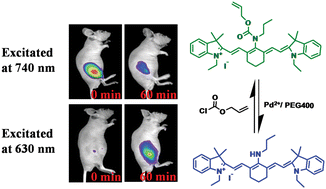
CyN1 chemosensor for detection of palladium
Palladium is all around us, from the catalytic converters in our cars to watches, jewellery and mobile phones. However, palladium ions can bind to DNA and proteins, leading to concerns that accumulation of the metal in human tissue may pose a health risk.
Fengling Song and Xiaojun Peng from the Dalian University of Technology, China, have developed a new near-infrared ratiometric fluorescent chemosensor for palladium. The CyN1 molecule is based on the structure of a cyanine dye and undergoes a Tsuji-Trost reaction in the presence of catalytic amounts of palladium.
The CyN1 sensor offers significant advantages over traditional methods of palladium detection such as atomic absorption spectroscopy (AAS) and inductively coupled plasma mass spectrometry (ICP-MS), which require expensive instrumentation and highly skilled analysts.
Demonstrating the potential bioapplications of the chemosensor, the authors used fluorescence imaging to conduct the first in vivo visualisation of palladium in living mice.
A near-infrared and ratiometric fluorescent chemosensor for palladium
Junyu Wang, Fengling Song,* Jingyun Wang and Xiaojun Peng*
Analyst, 2013, Advance Article
DOI: 10.1039/C3AN00616F










